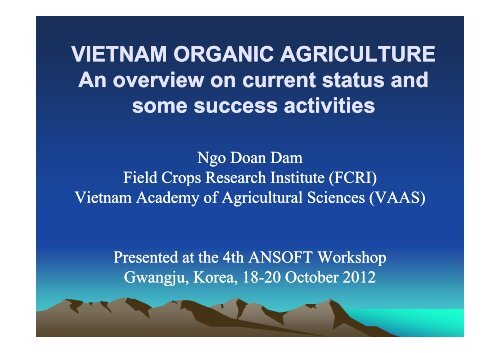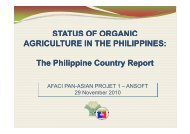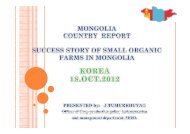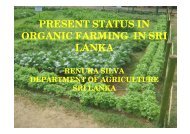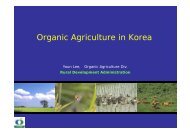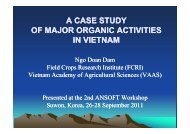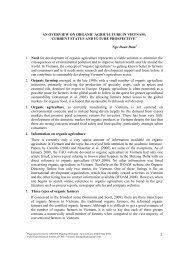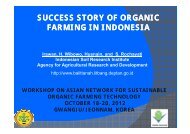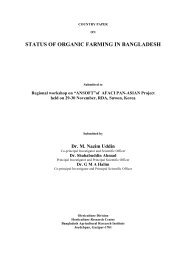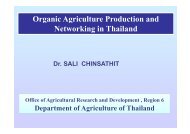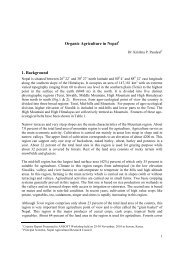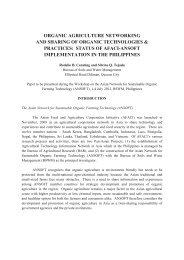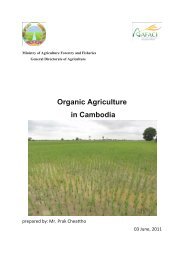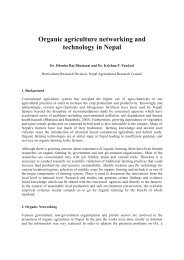2012 Vietnam ppt Gwangju.pdf - Afaci
2012 Vietnam ppt Gwangju.pdf - Afaci
2012 Vietnam ppt Gwangju.pdf - Afaci
Create successful ePaper yourself
Turn your PDF publications into a flip-book with our unique Google optimized e-Paper software.
VIETNAM ORGANIC AGRICULTURE<br />
An overview on current status and<br />
some success activities<br />
Ngo Doan Dam<br />
Field Crops Research Institute (FCRI)<br />
<strong>Vietnam</strong> Academy of Agricultural Sciences (VAAS)<br />
Presented at the 4th ANSOFT Workshop<br />
<strong>Gwangju</strong>, Korea, 18-20 October <strong>2012</strong>
CURRENT STATUS OF ORGANIC<br />
PRODUCTION<br />
Modern organic agriculture is new to<br />
<strong>Vietnam</strong>. Organic Information: Few<br />
and scattered.<br />
Certified organic area and value<br />
(2010):<br />
• 21.000 ha (0.2% of the total cropped<br />
area) of which h 7000 ha was for<br />
aquaculture (mainly shrimp).<br />
• Total export value: 12-14 million US$.<br />
Organic commodities: vegetables, tea,<br />
shrimp, and small amounts of<br />
specialty products, such as herbs,<br />
star anise, ginger, spices and<br />
essential oils… for export to Europe.
Organic certification and standards<br />
• National standards d are being developed.<br />
d<br />
• Foreign certifiers certify organic products for<br />
export (SKAL, ICEA/ACT, IMO, …)<br />
• ADDA-VNFU organic project collaborates with<br />
MARD to support development of national<br />
organic standards and certification.<br />
• Plan to set up national organic association and<br />
to issue organic "market" label. ADDA-VNFU<br />
organic project is one main partner to facilitate<br />
this plan.
Sales channels<br />
• Quantity of organic products is very few in food<br />
supply chain to market.<br />
• Shops, either more specialised "safe" food<br />
shops or more general food shops.<br />
• In some main markets there are now also some<br />
"safe“ vegetables sellers.<br />
• Hanoi Organics is operating a home delivery<br />
system for safe/ organic vegetables based on<br />
subscription and advance payments.
Research and Training Activities for<br />
organic agriculture production<br />
• Information on organic<br />
research results and training<br />
curriculum/ program in<br />
<strong>Vietnam</strong>ese or in English is<br />
very poor and scattered.<br />
• The available research results/<br />
activities mainly focus on new<br />
crop varieties and production<br />
technology development;<br />
producing better quality and<br />
safe crop products based on<br />
the ICM, good agricultural<br />
practices (GAP) principles.<br />
• Organic Prod’n training has not<br />
yet paid attention by the<br />
colleges/ universities.
MAJOR ORGANIC ACTIVITIES<br />
IN VIETNAM<br />
1. The ADDA-VNFU Project on Organic Farming<br />
http://sites.google.com/site/pgsvietnam/<br />
<br />
<br />
<br />
Project Duration: 1st Phase: 2006-2010. Extended<br />
2 more yrs: 2011-<strong>2012</strong>. <strong>2012</strong>.<br />
Aims: Increasing awareness and knowledge on<br />
organic agriculture for participated farmers and<br />
assisting them to produce organic products<br />
(mainly vegetables).<br />
Project area: 9 provinces (Lao Cai, Tuyen Quang,<br />
Bac Giang, Bac Ninh, Vinh Phuc, Hai Phong,<br />
Hanoi, Hoa Binh and Ha Tinh).
MAJOR ORGANIC ACTIVITIES<br />
IN VIETNAM<br />
1. The ADDA-VNFU Project on Organic Farming<br />
Major Results:155 training courses were organized, 88<br />
farmers grps were established to produce organic<br />
products (mainly vegetables and started with rice,<br />
orange, litchi, grapefruit, tea, fresh water fish...<br />
<br />
The successful grps are employing the Project<br />
developed participatory guarantee system (PGS) in<br />
their organic production (25 farmer grps completed<br />
registration (>240 farmers); 5 grps stopped > 20 grps<br />
active; 20 grps inspected (18 approved of which 16<br />
vegetables, 1 pomelo & 1 longan; 2 not). 164 farmers<br />
certified.
Most successful experience from<br />
ADDA_VNFU Project: the <strong>Vietnam</strong> PGS<br />
It has developed<br />
successfully PGS for<br />
farmers application. The<br />
PGS covers all aspects of<br />
prodn chain (input,<br />
production, harvesting,<br />
processing, transport &<br />
storage), focusing on<br />
parties who take ownership<br />
and/or modify product to the<br />
point of sale.
Experience of Tan Duc Group in Phu Tho province<br />
for organic vegetable production<br />
• Starting time: 1/2008<br />
• Group establishment: in 2010<br />
• Zone 1: 68 households<br />
– Group 1: 35 households<br />
– Group 2: 33 households<br />
– Field area: 34.840 m2<br />
• Zone 2: 83 households,<br />
– 10 groups,<br />
– 6-10 households/group<br />
– Area: 42,000 m2<br />
• Zone 3: 47 households<br />
• Area: 20,500 m2<br />
9
Learning how to make compost from available<br />
materials to have enough organic fertilizer for<br />
vegetable crops<br />
10
Main types of vegetables<br />
11
2. The ECOMART Company for Organic<br />
Tea and Vegetable www.ecomart.vn<br />
• Main business is to produce organic<br />
tea for exporting to European and US<br />
markets.<br />
• Production areas: Lao Cai 300 ha and<br />
Ha Giang 500 ha.<br />
• Main prod’n features: to use only the<br />
indigenous perennial tea variety Shan<br />
Tuyet and produced in the registered<br />
farms and trained farmers. Farms are<br />
applied with only organic compost, no<br />
in-organic fertilizer and insecticide<br />
application. All the fresh products are<br />
bought, processed and quality<br />
checked by the Company.<br />
• The strategy for quality assurance is to<br />
meet the quality standards set by each<br />
market, through strict internal quality<br />
assurance and dinspection and<br />
obtaining certificate from the client -<br />
required certifying body.
2. The ECOMART Company for<br />
Organic Tea and Vegetable<br />
• Economic benefit from<br />
organic tea: exported at<br />
5.5-6.0 US$/kg to the EU<br />
and dUS markets while the<br />
normal tea is sold at 2.2-<br />
2.5 US$/kg to Egyptian<br />
countries. ti<br />
However,<br />
share in domestic market<br />
is insignificant.<br />
• Organic vegetables: Just<br />
started with 20 kinds for<br />
some 2000 clients inside<br />
Hanoi. Employing PGS<br />
for quality assurance.
3. Organik Dalat for organic<br />
vegetables http://www.organikvn.com<br />
• Started full production in 2006.<br />
Total land 20 ha of which 6 is for<br />
organic vegetable production (105<br />
kinds).<br />
• Clients: 5-star hotels, Pacific<br />
Airline Food Processing, 1000<br />
foreign families working in<br />
<strong>Vietnam</strong>.<br />
• Has modern production and<br />
packaging facilities, including<br />
greenhouse, facilities for waste<br />
treatment, use of clean water to<br />
irrigate the crops; using organic<br />
compost for production.<br />
• Harmful chemicals and pesticides<br />
are not used to control insects and<br />
diseases. Careful records are kept<br />
of each crop's history in order to<br />
guarantee their customers that<br />
what they buy is not<br />
contaminated.
3. Organik Dalat for organic vegetables<br />
• Employing very well the<br />
IPM principles in their<br />
vegetable production,<br />
such as rotation, use of<br />
compost fertilizer and<br />
clean water for irrigation,<br />
use of flowers to rebel<br />
insects approaching to<br />
damage the crops.<br />
• Has obtained HACCP<br />
Certificate for their<br />
organic vegetables since<br />
2009.
3. Organik Dalat for organic vegetables
4. The Vien Phu Green Farm for<br />
Organic Rice http://vienphugreenfarm.com<br />
• Though <strong>Vietnam</strong> is one of the<br />
leading rice exporters, the organic<br />
rice res. and prod’n is still the<br />
infant stage.<br />
• Vien Phu Farm is 320 ha in Ca<br />
Mau Province. Commercial<br />
organic rice prod’n was started on<br />
70-80 ha in 2011 and expanded to<br />
some 200 ha in <strong>2012</strong>, using their<br />
own rice production protocol,<br />
seed, bio-organic rice cultivation<br />
protocol and processing line.<br />
• Paddy field is fully fertilized by<br />
Agrostim bio-organic fertilizer<br />
(accredited by Organic Material<br />
Review Institute - USA) without<br />
using any chemical fertilizers as<br />
well as chemical pesticides,<br />
insecticides, herbicides.
4. The Vien Phu Green Farm for Organic Rice<br />
• Paddy farming method<br />
combined is supervised and<br />
accredited by international<br />
certification organization as<br />
per EU and USDA Organic<br />
Standards.<br />
• Available organic rice<br />
products: fragrant white rice,<br />
black rice, purple rice, red rice<br />
and mixed color rice.<br />
• Has complied with the EU and<br />
USDA organic standards for<br />
their products but still face a lot<br />
of difficulties in expanding<br />
production scale due to their<br />
lack of agro-technical staff,<br />
market demand and quality<br />
assurance compliance…
5. The ecological shrimp model in Ca<br />
• Organic Shrimp Culture<br />
was first introduced into<br />
Ca Mau province in 1999<br />
and dthe first tfarms were<br />
certified in 2001 by<br />
Naturland.<br />
• The idea for organic<br />
shrimp culture came after<br />
aSwitzerland -supported<br />
forest project which<br />
promotes to maintain and<br />
expand the natural forest<br />
in the saline flooded area<br />
of the province.<br />
Mau province
5. The ecological shrimp model<br />
• The first organic shrimp project<br />
was implemented during 2003-<br />
2006, covering activities from<br />
training of farmers, selecting of<br />
production farms which must have<br />
at least 50% of the water surface<br />
covered by saline tolerant<br />
mangrove forest.<br />
• Current prod’n scale: 10,500 ha<br />
out of 23.151 ha of Ngoc Hien<br />
Forest farms. of which 6450 ha<br />
with 1238 farmers have been<br />
certified as organic shrimp<br />
compliance.<br />
• This project helps to increase<br />
farmers income at the selling price<br />
20% higher than the normal<br />
shrimp while they can still have<br />
income from forest activities.<br />
Farmers can harvest up to 450 kg<br />
of shrimp/ha a year at a selling<br />
price of 10-15 US$/kg.
5. The ecological shrimp model<br />
• The model has a good<br />
production and quality<br />
assurance in organic shrimp<br />
culture; including certifying the<br />
registered production farm,<br />
employ the standard<br />
production procedure, internal<br />
control system (ICS), quality<br />
certified by IMO, Naturland and<br />
BIOSUISSE.<br />
• The organic shrimp of this<br />
Company is currently exported<br />
to Switzerland.
6. National Workshop for Organic<br />
Research Development<br />
‣ Time: A full day on 28 Feb. <strong>2012</strong>.<br />
‣ Host: <strong>Vietnam</strong> Academy of Agricultural<br />
Science (VAAS)<br />
‣ Participants: 60 (doubled as planned),<br />
including policy makers, scientists,<br />
education/ training centers,<br />
businesses and organizations who are<br />
considered as the pioneers in the<br />
organic agriculture movement in<br />
<strong>Vietnam</strong>.
6. National Workshop for Organic<br />
Research Development<br />
‣ 15 papers presented, covering topics on<br />
the prod’n technologies, marketing,<br />
advantages and difficulties for the<br />
development of organic agriculture in<br />
<strong>Vietnam</strong>.<br />
‣ The workshop proceeding in <strong>Vietnam</strong>ese<br />
was published and distributed to all the<br />
participants.<br />
p<br />
‣ The workshop results were also informed<br />
through public media.<br />
‣ A national net-working among the organic<br />
members has been formed for<br />
information exchange and sharing of<br />
experiences.
7. <strong>Vietnam</strong> Organic Association was founded<br />
and its First Congress was held<br />
‣ On 31st October 2011, the Gov. Of<br />
<strong>Vietnam</strong> decided to establish <strong>Vietnam</strong><br />
Organic Association (VOA).<br />
‣ The VOA is specified as a social<br />
vocational organization with participation<br />
of individuals, organization, enterprises,<br />
scientific units, cooperatives, groups<br />
who have concerns and hearted<br />
enthusiasm to organic agriculture, who<br />
directly produce, process, do business,<br />
providing services, export and use<br />
organic products in many provinces and<br />
cities.
7. <strong>Vietnam</strong> Organic Association was<br />
founded and its First Congress was held<br />
• The FCRI project team took part in the progress of preparation and<br />
organization of the First VOA Congress.<br />
• On May 22nd <strong>2012</strong>, <strong>Vietnam</strong> Farmer Union (VNFU) led and organized<br />
the First VOA Congress in Hanoi with which the VOA was officially<br />
launched.<br />
• 158 representatives attended, including scientists, organizations,<br />
business, consumers and farmers concerning about organic production.<br />
• The Congress elected the VOA’s Executive Committee of 19 members<br />
chaired by Vice President of <strong>Vietnam</strong> Farmer Union.<br />
• President of VAAS and representatives of several VAAS member<br />
institutes have joined and taken part in the Congress activities.
7. <strong>Vietnam</strong> Organic Association was<br />
founded and its First Congress was held<br />
‣ VOA is aimed at mobilizing people with<br />
passion and interest to participate for<br />
promoting the sustainable development<br />
of <strong>Vietnam</strong> organic agriculture, creating<br />
high-quality products, hygiene and food<br />
safety, contributing to protect human<br />
health, maintaining voice, ecological<br />
environmental protection, reduce the<br />
harmful effects of global climate change,<br />
meet the requirements of international<br />
economic integration.
8. Technology transfer to farmers<br />
using demonstration farms<br />
‣ In the <strong>2012</strong>, the Project has helped<br />
farmers groups in Luong Son District of<br />
Hoa Binh province in producing organic<br />
vegetables.<br />
‣ Farmers are trained how to make<br />
compost, to use clean organic seed, to<br />
control pest and disease by biopesticides.<br />
‣ With these activities, the farmers groups<br />
can self-run their business, producing<br />
qualified organic vegetable for a number<br />
of fhigh hdemanding di customers.
9. Some locally developed organic<br />
technologies<br />
9.1. Using Trichoderma to produce compost from rice straw<br />
‣ Purpose of use: Stimulating the decomposition of fresh rice straw<br />
to produce compost.<br />
‣ Trichoderma can attact Rhizoctonia solani, Fusarium solani,<br />
Phytophtora, Sclerotium rolfsii…<br />
‣ Trichoderma also promotes activities of some enzymes such as<br />
cellulase, chitinase, protease, pectinase, amlylase which help the<br />
decomposition of cellulose, chitin, lignin, pectin in the plant<br />
residues to make nutrition for the followed crops.
9. Some locally developed organic<br />
technologies<br />
9.1. Using Trichoderma to produce<br />
compost from rice straw<br />
‣ Using Method: For each tone of fresh rice<br />
straw, 0.3 - 0.5 kg of Trichoderma product<br />
and 100 ml of Amino Humate or Amino<br />
Chelate are diluted in 70 liters of water.<br />
‣ Spraying the mix on fresh rice straw and<br />
cover with plastics. Maintain proper<br />
moister. The compost is best for use in<br />
15-20 days.
9. Some locally developed organic<br />
technologies<br />
9.2. Using growing Substrate GT5 to produce<br />
young vegetables.<br />
‣ The growing organic substrate GT05 is<br />
produced by the Soil and Fertiliser<br />
Research Institute (SFRI).<br />
‣ It contains 44% OM; 1.2% N; 0.8% P2O5;<br />
0.7% K2O; and some other macro- and<br />
micro-nutrients.<br />
‣ The product is licensed by the Ministry of<br />
Agriculture and Rural Development for<br />
commercial application.
9. Some locally developed organic<br />
technologies<br />
9.2. Using growing Substrate GT5 to produce<br />
young vegetables for salad.<br />
‣ Some 12 kg of GT5 substrate is put into<br />
1m2 tray to make a layer of 3-5 cm for<br />
growing 5 beaches of young vegetable.<br />
After each harvesting beach, the substrate<br />
is re-used for the next seed sowing.<br />
‣ Using this technique for raising spinach,<br />
growers can harvest 1.34 kg of vegetables<br />
per m2 in 1 week and 6.7 kg of vegetable 5<br />
harvests.<br />
‣ The substrate can also be used to produce<br />
cut vegetable in home garden with the<br />
productivity it of 2.16 kg/m2 in 1 week and<br />
10.83 kg/m2 in 4-5 weeks.
9. Some locally developed organic<br />
technologies<br />
9.3. Research results on developing bio-pesticides to control<br />
pest and diseases in crops prod’n.<br />
‣ The PPRI has conducted research and developed successfully<br />
some bio-pro44ducts: such as MT1, BE, BC SH1, BIOFUN,<br />
Metarhizium anisopliae, BOURBO 8.3BR and TICTACK 13.2BR<br />
to help the production of organic and safe agricultural products.<br />
These include:<br />
‣ The bio-product MT1 for application into the base of black<br />
pepper plants to control nematodes.<br />
‣ Bio-products BE (using Bacillus vallismortis) and BC (using<br />
Bacillus subtilis) to control bacterial wilt (Ralstonia<br />
solanacearum) and yellow wilting (Fusarium solani) on tomato<br />
and potato.
9. Some locally developed organic<br />
technologies<br />
9.3. Research results on developing biopesticides<br />
to control pest and diseases<br />
in crops productions.<br />
‣ SH1 to control nemathods Meloidogyne sp.<br />
and some soil-borne diseases caused by<br />
Fusarium, Phytopthora and Pythium on<br />
cofee and black peper crops.<br />
M.A extract<br />
‣ M.a (using Metarhizium anisopliae) ) to<br />
control rice plant hopper.<br />
‣ The Institute also produces 3 bio-products<br />
SOD, SOY and SOP from Neem plant<br />
(Azadirachta indica var. siamensis) to<br />
control insects in storing rice grains.<br />
‣ BOURBO 8.3BR and TICTACK 13.2BR to<br />
control golden snails in rice production.
9. Some locally developed organic<br />
technologies<br />
9.4.Research R h on producing organic rice<br />
using bio-pesticides and biofertilizers<br />
The FCRI has recently conducted studies<br />
on producing organic rice under the Red<br />
River Delta conditions. The results indicate<br />
that:<br />
M.A extract<br />
‣ Organic rice can be produced with the<br />
application of bio-fertilizers in combination<br />
with pig-manure. Rice yield is reduced by<br />
6.4 - 9.0% as compared to the conventional<br />
method; however, the rice quality is<br />
significantly improved with lower nitrate<br />
content and other chemical residues.
9. Some locally developed organic<br />
technologies<br />
9.4. Research on producing organic rice using biopesticides<br />
and bio-fertilizers<br />
‣ The application of bio-pesticides such as Catex 1.8 EC, SUSUPES 1.9<br />
EC, DITACIN 8L, ELCARIN... instead of chemical pesticides in organic<br />
rice production can reduce pest and disease damages and improving<br />
rice quality (no Fipronil chemical residues are present in rice grain).<br />
‣ The application of bio-products can also improve soil pH, increase<br />
organic matter and plant nutrition.<br />
‣ One ha of organic rice crop should be applied with a rate of 1 ton of<br />
BIOGRO fertiliser + 8 -10 ton of decomposed farm manure; foliage<br />
spraying of bio-fertiliser for rice seedling and rice crop at every 15-day<br />
intervals can improve rice yield and rice quality.
CONCLUSIONS<br />
1. The organic farming has not yet played an<br />
important role in <strong>Vietnam</strong> agriculture sector.<br />
• As of 2010, the certified organic area was only<br />
some 21.000 ha (0.2% of the total cropped<br />
area). The total export value was some 12-1414<br />
million US$.<br />
• The major organic commodities include<br />
vegetables, tea, shrimp though efforts have<br />
been expanded to other products such as rice,<br />
oranges, litchi, longan, cinnamon, ginger,<br />
bassa fish…
CONCLUSIONS<br />
2. There is still a lack of specific Government policies i to<br />
support the development of organic agriculture. There<br />
is still little attention on organic farming from research,<br />
training and the extension service.<br />
3. However, there have been some good models for<br />
organic production in <strong>Vietnam</strong>:<br />
• The ADDA-VNUF project on organic vegetable for<br />
domestic markets;<br />
• ECOMART for organic tea production to export to<br />
European countries and US;
CONCLUSIONS<br />
• Organic shrimp in combination with forestation ti in Ca<br />
Mau for exporting to Switzerland;<br />
• ORGANIK Dalat for vegetable production to meet the<br />
demand of high demanding markets and customers.<br />
• Initial efforts are also being gpursued to produce<br />
organic rice in VIENPHU Green Farm for exporting to<br />
US market.<br />
• Lately, National Workshop for Organic Agriculture<br />
Promotion was held by VAAS; <strong>Vietnam</strong> Organic Ass’n<br />
was founded and its 1 st Congress was organized.<br />
Organic tech. transfer to farmers has been going on by<br />
the FCRI and other institutions.
CONCLUSIONS<br />
4. Quality assurance for organic produces is<br />
complied differently from one company to<br />
another. The PGS is a good tool to help<br />
farmers to produce good organic<br />
vegetables for domestic markets.<br />
• The productions of all the export-oriented<br />
products follow the quality certification<br />
systems of the imported countries.
PROPOSE<br />
‣ The Korean Gov. to consider for an<br />
extension of the ANSOFT in the 2 nd phase<br />
(ideally 3 years).<br />
‣If approved, the 2 nd phase of ANSOFT<br />
should focus on: reinforcing national and<br />
regional organic networking; sharing<br />
experiences and good technical practices,<br />
and enhance technology transfer activities<br />
to farmers
Thank you


